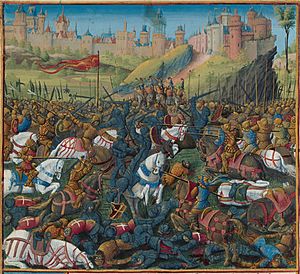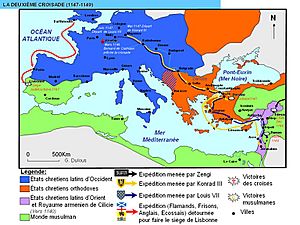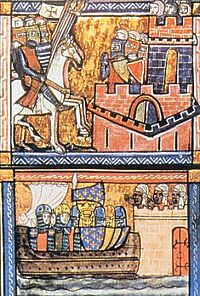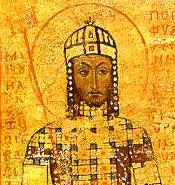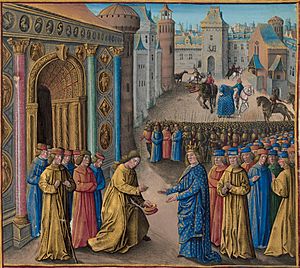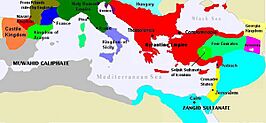Second Crusade facts for kids
The Second Crusade (1147–1150) was a big military journey from Europe. It began because the County of Edessa, a Christian state, fell to Muslim forces in 1144. Edessa was one of the first Crusader states created during the First Crusade (1096–1099). It was also the first one to be lost.
Pope Eugene III officially called for the Second Crusade. It was the first time European kings, Louis VII of France and Conrad III of Germany, led a crusade. Other European nobles also joined. The armies marched separately across Europe. After entering Anatolia (modern-day Turkey), both armies were defeated by the Seljuk Turks. Some Christian writers claimed the Byzantine Emperor Manuel I Komnenos secretly worked against the crusaders. However, this idea was likely made up by those who saw the Byzantine Empire as a problem.
Louis and Conrad, with what was left of their armies, reached Jerusalem. In 1148, they attacked Damascus, a Muslim city, but it was a bad idea and they had to retreat. The crusade in the East failed for the Christians and was a victory for the Muslims. This failure later played a part in the fall of Jerusalem and led to the Third Crusade.
Even though the Second Crusade failed in the Holy Land, crusaders did win some battles elsewhere. A large group of crusaders from different parts of Europe helped the Portuguese army capture Lisbon in 1147. They drove out the Moorish (Muslim) rulers.
At first, not many people wanted to join the new crusade. But when King Louis VII of France decided to go, the Pope reissued his call. Louis had already been thinking about a trip to the Holy Land. He wanted to keep a promise his dead brother had made. Abbot Suger and other nobles did not want Louis to leave his kingdom for years. Louis asked Bernard of Clairvaux for advice, who then sent him back to the Pope. Pope Eugene strongly supported Louis's plan. The Pope then asked Bernard to spread the word about the crusade across France.
Contents
Why the Crusade Started
The Fall of Edessa
After the First Crusade, four Christian states were set up in the East: the Kingdom of Jerusalem, the Principality of Antioch, the County of Edessa, and the County of Tripoli. Edessa was the northernmost state. It was also the weakest and had the fewest people. Because of this, it was often attacked by nearby Muslim states.
The rulers of Edessa, Baldwin II of Jerusalem and Joscelin I of Edessa, were captured in battle more than once. Even though Edessa improved a bit after the Battle of Azaz in 1125, Joscelin I was killed in 1131. His son, Joscelin II of Edessa, had to make a deal with the Byzantine Empire. But in 1143, both the Byzantine emperor and the King of Jerusalem died. Joscelin II also had arguments with the leaders of Tripoli and Antioch. This left Edessa without strong friends.
Meanwhile, Imad ad-Din Zengi, a powerful Muslim leader, took control of Aleppo in 1128. This city was very important for power in Syria. Zengi also wanted to take Damascus. Damascus, ruled by the Burid dynasty, made a deal with King Fulk of Jerusalem when Zengi attacked them in 1139 and 1140.
In late 1144, Joscelin II left Edessa with most of his army to help an ally. Zengi quickly used this chance to attack Edessa. The city fell to him on December 24, 1144. Help from Jerusalem arrived too late. Joscelin II tried to rule the rest of his land from another city, but Muslims slowly took over the remaining areas. Zengi was praised by Muslims as a "defender of the faith." He was killed in 1146. His son, Nur ad-Din Zangi, took over in Aleppo.
The Pope's Call and French Plans
News of Edessa's fall reached Europe in early 1145. Pope Eugene III then issued an official letter called Quantum praedecessores on December 1, calling for a second crusade. The Pope lived in Viterbo, not Rome, at this time. The Second Crusade was planned to be more organized than the First. Strong kings would lead the armies, and a route would be planned ahead of time.
Saint Bernard of Clairvaux's Role
The Pope asked a French abbot named Bernard of Clairvaux to preach about the Second Crusade. Bernard offered the same special religious rewards that were given for the First Crusade. A big meeting was held in Vezelay, France, in 1146. Bernard spoke to the crowd on March 31. Louis VII of France, his wife Eleanor of Aquitaine, and many nobles promised to join the crusade. Bernard then traveled to Germany. Many miracles were reported wherever he went, which helped his mission succeed. In Speyer, Conrad III of Germany and his nephew, Frederick Barbarossa, also joined. Pope Eugene himself came to France to encourage the effort.
Bernard was a very passionate speaker, but he was not unfair or cruel. However, just like in the First Crusade, his preaching accidentally led to attacks on Jewish people. A monk named Rudolf was encouraging massacres of Jews in Germany. He claimed Jews were not helping to pay for the Holy Land's rescue. Bernard, along with the Archbishops of Cologne and Mainz, strongly opposed these attacks. Bernard traveled to Germany to stop Rudolf and calm the angry crowds. He found Rudolf in Mainz and sent him back to his monastery.
Crusades in Spain and Portugal
In the spring of 1147, the Pope allowed the crusade to expand into the Iberian peninsula (Spain and Portugal). This was part of the Reconquista, the Christian effort to retake land from the Moors (Muslims). The Pope also said that King Alfonso VII of León and Castile's fights against the Moors were just as important as the rest of the Second Crusade.
In May 1147, the first groups of crusaders sailed from England towards the Holy Land. Bad weather forced their ships to stop in Porto, Portugal, on June 16, 1147. There, they met with King Afonso I of Portugal.
The crusaders agreed to help the King attack Lisbon. They made a deal that they could take goods from the city and get money for any prisoners. Some crusaders were unsure, remembering a failed attack on Lisbon in 1142. The siege of Lisbon in 1147 lasted from July 1 to October 25. After four months, the Moorish rulers gave up because of hunger inside the city. Many crusaders stayed in the newly captured city. Some continued their journey to the Holy Land. Others had helped capture Santarém earlier that year. Later, they also helped conquer other towns like Sintra and Almada. They were allowed to settle in these new lands.
Elsewhere in Spain, King Alfonso VII of León and Count Ramon Berenguer IV of Barcelona led a mixed army against the rich port city of Almería. With help from ships from Genoa and Pisa, the city was captured in October 1147.
Ramon Berenguer then attacked the lands of the Almoravids. The crusaders who had helped in Lisbon were encouraged to join the siege of Tortosa (1148). In December 1148, Tortosa was captured after a five-month siege. This was also with help from French, German, Flemish, English, and Genoese crusaders. Many crusaders were given land in and around the captured city. The next year, other cities like Fraga and Lleida also fell to his army.
Military Forces
Muslim Armies
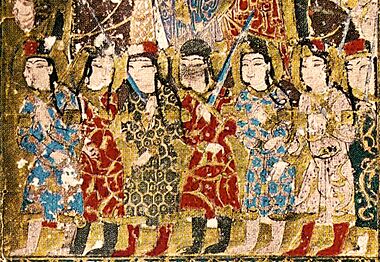
The professional soldiers of the Muslim states were usually from Turkey. They were very well-trained and had good equipment. The military system relied on a system where land was given to support soldiers. In times of war, city militias, made up mostly of Arabs, were called to join. These militias were not as well-trained as the Turkish soldiers, but they were often very motivated by their religion, especially the idea of jihad (holy struggle). Other support came from Turkoman and Kurdish fighters, but these groups were sometimes hard to control.
The main Muslim commander was Mu'in ad-Din Unur, who was the ruler of Damascus from 1138 to 1149. While the Burid family was officially in charge, Unur, who led the military, was the real power. Historians describe Unur as a skilled general and diplomat. Later, another family, the Zengids, took over Damascus. Because of this, Unur's role in stopping the Second Crusade was often forgotten. Zengid historians gave the credit to their own leader, Nur ad-Din Zengi, who was Unur's rival.
Crusader Armies
The German army had about 20,000 knights. The French army had about 700 knights from the king's own lands, plus smaller groups from other nobles. The Christian Kingdom of Jerusalem had about 950 knights and 6,000 foot soldiers.
French knights liked to fight on horseback. German knights preferred to fight on foot. A Greek writer named John Kinnamos said that "the French are especially good at riding horseback in order and attacking with the spear." He also said, "their cavalry is faster than the Germans'. The Germans, however, can fight on foot better than the French and are excellent with the great sword."
King Conrad III of Germany was known as a brave knight. However, he was often unsure about what to do in difficult situations. King Louis VII of France was a very religious Christian. Some people at the time criticized him for caring more about his wife, Eleanor of Aquitaine, than about war or politics.
King Stephen, King of England did not join the Second Crusade. He had problems in his own kingdom. King David I of Scotland was also advised by his people not to go.
The Crusade in the East
After Zengi was killed, Joscelin II tried to take back Edessa. But Nur ad-Din defeated him in November 1146. On February 16, 1147, the French crusaders met to plan their route. The Germans had already decided to travel by land through Hungary. They thought the sea route was too risky because Roger II of Sicily was an enemy of Conrad. Many French nobles did not trust the land route through the Byzantine Empire. Still, the French decided to follow Conrad and leave on June 15. Roger II was upset and refused to help. In France, Abbot Suger was chosen to rule the kingdom while the king was away. In Germany, more people joined the crusade. The Germans planned to leave at Easter but did not start until May.
The German Journey
The German crusaders, with a papal leader, planned to meet the French in Constantinople. Ottokar III of Styria joined Conrad in Vienna. Conrad's enemy, Géza II of Hungary, allowed them to pass safely. When the German army of 20,000 men reached Byzantine land, Emperor Manuel I Komnenos worried they might attack him. He sent Byzantine troops to watch them. There was a small fight with some unruly Germans near Philippopolis and Adrianople. To make things worse, some German soldiers died in a flood in September. On September 10, they arrived in Constantinople. Relations with Manuel were not good. After a battle near Constantinople, the Germans decided to cross into Asia Minor (modern-day Turkey) as quickly as possible. Manuel wanted Conrad to leave some troops to help against attacks from Roger II, but Conrad refused.
In Asia Minor, Conrad decided not to wait for the French. He marched towards Iconium, the capital of the Seljuq Sultanate of Rûm. Conrad split his army into two groups. Much of the Byzantine Empire's control in western Asia Minor was weak. Many areas were controlled by Turkish nomads. Conrad did not realize how long the march would be. He also thought Emperor Manuel had more control in Anatolia than he actually did. Conrad took the knights and best soldiers with him to march by land. He sent the rest of the army with Otto of Freising to follow the coast.
The Seljuqs almost completely destroyed King Conrad's group on October 25, 1147, at the second battle of Dorylaeum. The Turks used their usual trick: they pretended to run away, then came back to attack the small group of German cavalry that had chased them. Conrad began a slow retreat back to Constantinople. His army was attacked daily by the Turks, who targeted stragglers and defeated the rear guard. Conrad himself was hurt in a fight. The other part of the German force, led by Otto of Freising, marched south to the coast. They were also defeated in early 1148. Otto's group ran out of food while crossing difficult land. They were ambushed by the Seljuq Turks near Laodicea on November 16, 1147. Most of Otto's force were either killed or captured and sold as slaves.
The French Journey
The French crusaders left Metz in June 1147. They were led by King Louis and other nobles. Armies from different regions of France joined them. A group from Provence decided to wait until August and travel by sea. In Worms, Louis met with crusaders from Normandy and England. They followed Conrad's route fairly peacefully. However, Louis had a conflict with King Géza of Hungary because Louis allowed a Hungarian who had tried to take Géza's throne to join his army. Relations in Byzantine territory were also difficult.
Emperor Manuel I had made a peace deal with his enemy, Sultan Mesud I. Manuel did this so he could focus on defending his empire from the crusaders. Crusaders had a reputation for stealing and causing trouble. They were also suspected of wanting to attack Constantinople. Still, Manuel's relations with the French army were better than with the Germans. Louis was treated very well in Constantinople. Some French crusaders were angry about Manuel's peace deal with the Seljuqs. They wanted to join with Roger II and attack Constantinople, but Louis stopped them.
When the armies from Savoy and other regions joined Louis in Constantinople, they crossed the Bosporus by ship to Asia Minor. The Greeks were encouraged by rumors that the Germans had captured Iconium. But Manuel refused to give Louis any Byzantine troops. Roger II of Sicily had just invaded Byzantine land, so Manuel needed all his army in the Peloponnese. Both the German and French armies entered Asia without any Byzantine help. This was different from the First Crusade. Manuel made the French promise to return any land they captured to the Byzantine Empire.
The French met the remaining German soldiers at Lopadion. Conrad joined Louis's army. They followed Otto of Freising's route, staying closer to the Mediterranean coast. They reached Ephesus in December. There, they learned that the Turks were preparing to attack them. Manuel also sent messages complaining about the French stealing and plundering along the way. There was no guarantee the Byzantines would help them against the Turks. Meanwhile, Conrad got sick and went back to Constantinople, where Manuel personally cared for him. Louis, ignoring warnings of a Turkish attack, marched out from Ephesus with the French and German survivors. The Turks were indeed waiting to attack. However, at the Battle of Ephesus on December 24, 1147, the French won. The French fought off another Turkish ambush at the Battle of the Meander that same month.
They reached Laodicea on the Lycus in early January 1148. This was just after Otto of Freising's army had been destroyed in the same area. As they continued their march, the front group, led by Amadeus of Savoy, got separated from the rest of the army at the Battle of Mount Cadmus. Louis's troops suffered heavy losses from the Turks on January 6, 1148. According to one writer, Louis himself climbed a rock and was not recognized by the Turks. The Turks did not attack further. The French marched on to Attalia. The Turks kept harassing them from a distance. They also burned the land to stop the French from finding food for themselves and their horses. Louis no longer wanted to continue by land. They decided to gather ships at Attalia and sail to Antioch. After being delayed for a month by storms, most of the promised ships did not arrive. Louis and his close companions took the few ships that did arrive. The rest of the army had to continue the long march to Antioch. This part of the army was almost completely destroyed by the Turks or by sickness.
Journey to Jerusalem
Even with delays from storms, Louis finally arrived in Antioch on March 19. Amadeus of Savoy had died in Cyprus on the way. Louis was welcomed by Eleanor's uncle, Raymond of Poitiers.
Raymond expected Louis to help defend against the Turks. He also wanted Louis to join him on a trip to attack Aleppo, a Muslim city that was key to reaching Edessa. But Louis refused. He preferred to finish his pilgrimage to Jerusalem rather than focus on the military part of the crusade.
Eleanor enjoyed her stay in Antioch. Her uncle urged her to stay and help expand their family's lands. He even suggested she divorce Louis if the king would not help the crusade's military goals. During this time, there were rumors of a close relationship between Raymond and Eleanor. This caused problems in Louis and Eleanor's marriage.
Louis quickly left Antioch for Tripoli, taking Eleanor with him. Meanwhile, Otto of Freising and the rest of his troops arrived in Jerusalem in early April. Conrad arrived soon after. The Latin Patriarch of Jerusalem was sent to invite Louis to join them. The fleet that had stopped in Lisbon also arrived around this time. So did the crusaders from Provence, who had left Europe under the command of Alfonso Jordan.
Alfonso himself did not reach Jerusalem. He died in Caesarea. It was rumored that he was poisoned by Raymond II of Tripoli, who was his nephew. Raymond feared Alfonso's plans for power in the county. The claim that Raymond had poisoned Alfonso caused many of the Provençal forces to turn back and go home. The original goal of the crusade was Edessa. However, King Baldwin III and the Knights Templar preferred to attack Damascus.
When the crusaders arrived, the ruler of Damascus, Mu'in ad-Din Unur, began to prepare for war. He made Damascus's defenses stronger. He ordered troops to his city and destroyed or changed water sources along the road to Damascus. Unur asked for help from the Zengid rulers of Aleppo and Mosul, who were usually his rivals. However, forces from these states did not arrive in time for the battle outside Damascus. It is very likely that the Zengid rulers delayed sending troops. They hoped their rival Unur might lose his city to the crusaders.
The Council of Palmarea
The nobles of Jerusalem were happy about the arrival of troops from Europe. A meeting was held on June 24, 1148, to decide the best target for the crusaders. The leaders of Jerusalem met with the newly arrived crusaders from Europe at Palmarea, near Acre. This was a very important meeting.
In the end, they decided to attack Damascus. Damascus had been an ally of the Kingdom of Jerusalem. But it had changed its loyalty to the Zengids and attacked the Kingdom's allied city of Bosra in 1147. Historians have often called the decision to attack Damascus instead of Edessa "a very foolish act." Many historians have argued that it would have been better for the crusaders to focus on the Zengids. This is because of the tensions between Unur, the ruler of Damascus, and the growing power of the Zengids. More recently, some historians have defended the decision to attack Damascus. They argue that Damascus was the most powerful Muslim state in southern Syria. If the Christians held Damascus, they would be in a better position to fight the rising power of Nur ad-Din. Since Unur was clearly the weaker of the two Muslim rulers, it seemed likely that Nur ad-Din would take Damascus soon. So, it seemed better for the crusaders to hold that city instead of the Zengids. In July, their armies gathered at Tiberias and marched to Damascus, going around the Sea of Galilee. There were probably about 50,000 troops in total.
The Siege of Damascus
The crusaders decided to attack Damascus from the west. This area had many orchards, which would give them a steady supply of food. They arrived at Darayya on July 23. The next day, the Muslims were ready for the attack. They constantly attacked the army moving through the orchards outside Damascus. The defenders had asked for help from Saif ad-Din Ghazi I of Mosul and Nur ad-Din of Aleppo. Nur ad-Din personally led an attack on the crusader camp. The crusaders were pushed back from the city walls into the orchards. This left them open to ambushes and surprise attacks.
According to William of Tyre, on July 27, the crusaders decided to move to the plain on the eastern side of the city. This side was not as strongly defended, but it had much less food and water. Some records say that Unur bribed the leaders to move to a weaker position. Unur also supposedly promised to end his alliance with Nur ad-Din if the crusaders went home. Meanwhile, Nur ad-Din and Saif ad-Din had arrived. With Nur ad-Din's army nearby, the crusaders could not return to their better position. The local crusader lords refused to continue the siege. The three kings had no choice but to leave the city. First Conrad, then the rest of the army, decided to retreat to Jerusalem on July 28. During their entire retreat, they were followed by Turkish archers who constantly attacked them.
What Happened Next
Each of the Christian groups felt that the others had betrayed them. A new plan was made to attack Ascalon. Conrad took his troops there, but no more help arrived. This was because of the lack of trust caused by the failed siege. This distrust lasted for a long time and hurt the Christian kingdoms in the Holy Land. After leaving Ascalon, Conrad returned to Constantinople to strengthen his alliance with Manuel. Louis stayed in Jerusalem until 1149. The problems also affected Louis and Eleanor's marriage, which had been falling apart during the crusade. In April 1149, Louis and Eleanor, who were barely speaking, took separate ships back to France.
Back in Europe, Bernard of Clairvaux felt ashamed by the defeat. He felt it was his duty to apologize to the Pope. He wrote that the crusaders' sins caused their bad luck and failures. When his attempt to call for a new crusade failed, he tried to distance himself from the disaster of the Second Crusade. He died in 1153.
The Second Crusade had a big cultural impact in France. Many poets were interested in the rumored relationship between Eleanor and Raymond. This helped to develop the idea of courtly love. Unlike Conrad, Louis's image improved after the Crusade. Many French people saw him as a suffering king who quietly accepted God's punishments.
Relations between the Byzantine Empire and the French were badly damaged by the Crusade. Louis and other French leaders openly accused Emperor Manuel I of working with the Turks to attack them during their march across Asia Minor. The memory of the Second Crusade shaped how the French viewed the Byzantines for the next century. Within the Byzantine Empire, the crusade was seen as a success of diplomacy.
In the East, the situation became much worse for the Christians. In the Holy Land, the Second Crusade had terrible long-term effects for Jerusalem. In 1149, the ruler Unur died. After his death, there was fighting within Damascus. This led to the end of the Burid state within five years. Damascus no longer trusted the crusader kingdom. Nur ad-Din took Damascus after a short siege in 1154.
Baldwin III finally captured Ascalon in 1153. This brought Egypt into the conflict. Jerusalem was able to advance further into Egypt, even briefly occupying Cairo in the 1160s. However, relations with the Byzantine Empire were mixed. Few new soldiers came from Europe after the disaster of the Second Crusade. King Amalric I of Jerusalem allied with the Byzantines and joined a combined attack on Egypt in 1169, but it failed. In 1171, Saladin, a nephew of one of Nur ad-Din's generals, became Sultan of Egypt. He united Egypt and Syria, completely surrounding the crusader kingdom. Meanwhile, the alliance with the Byzantine Empire ended when Emperor Manuel I died in 1180. In 1187, Jerusalem surrendered to Saladin. His forces then spread north, capturing almost all the Crusader States' main cities. This led to the Third Crusade.
See also
 In Spanish: Segunda cruzada para niños
In Spanish: Segunda cruzada para niños


